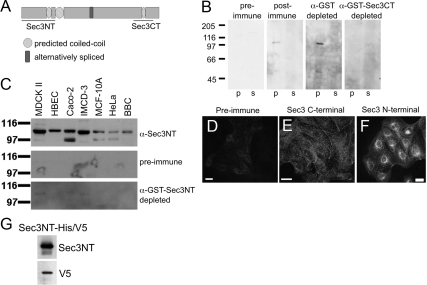Figure 1.
Antibodies to Sec3 are specific. (A) Schematic representation of human Sec3. Three coiled-coil motifs (amino acids 152-176, 205-257, and 742-764) are predicted by the COILS program. Lines indicate regions of the protein that were used to generate antibodies. The N-terminal Sec3 (Sec3NT) peptide encompasses amino acids 2-205, and the C-terminal Sec3 (Sec3CT) peptide consists of amino acids 692-818. (B) The specificity of the anti-Sec3CT antibody was examined by Western blotting. A 100,000 × g postnuclear membrane pellet (p) and supernatant (s) were resolved by SDS-PAGE, and immunoblotted with Sec3CT preimmune serum, postimmune serum, and postimmune serum depleted of either glutathione transferase (GST) or GST-Sec3CT antibodies. Specific Sec3 signal was present only in the membrane fraction (p). (C) The specificity of the anti-Sec3NT antibodies was examined by Western blotting. 15 μg of RIPA lysates of MDCK, HBEC, Caco-2, IMCD-3, MCF-10A, and HeLa cells and also BBC, were resolved by SDS-PAGE and blotted against anti-Sec3NT preimmune, postimmune, and postimmune serum depleted of anti-GST-Sec3NT antibodies. In all cell lines and the BBC, a band corresponding to the predicted mass of Sec3 (102 kDa) was present. The smaller band present in some samples might represent a splice variant or be a consequence of protein degradation. (D and E) The specificity of anti-Sec3CT antibodies was examined by immunofluorescence. MDCK cells were fixed and labeled with anti-Sec3CT preimmune (D) or postimmune (E) serum. Anti-Sec3CT antibodies specifically labeled puncta on the plasma membranes and in the cytoplasm. (F) Anti-Sec3NT antibodies also labeled the plasma membranes in a punctate pattern but, in addition, labeled the perinuclear region. (G) 0.5 μg of the Sec3NT immunogen (Sec3NT-His/V5) was resolved by SDS-PAGE and immunoblotted with anti-Sec3NT and anti-V5 antibodies. Both the anti-V5 and anti-Sec3NT antibodies recognized the immunogen.

